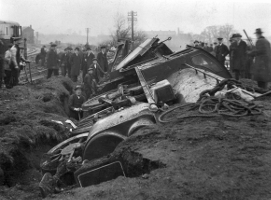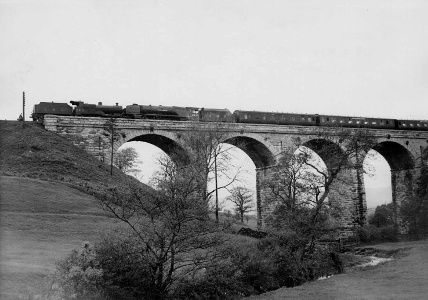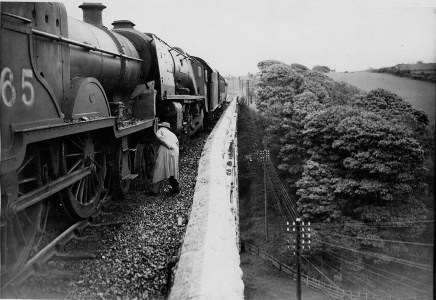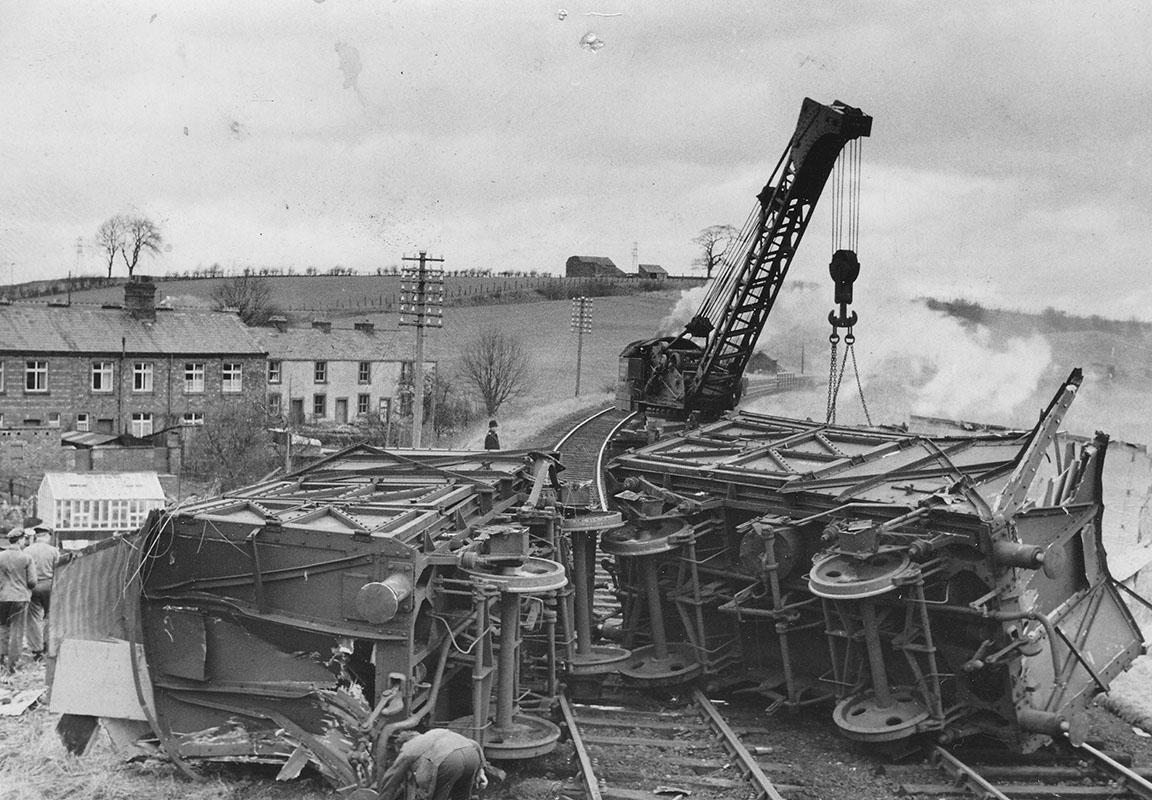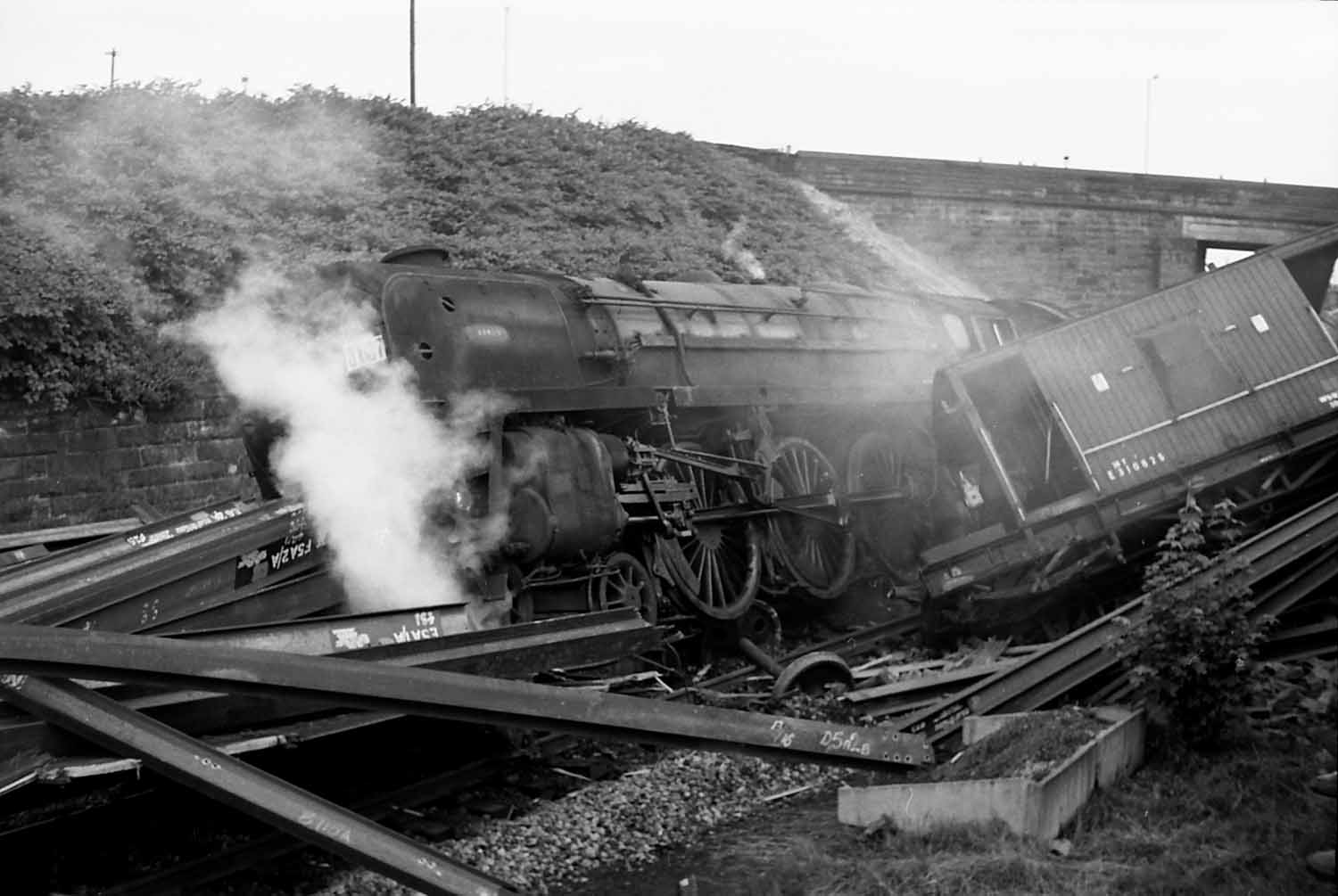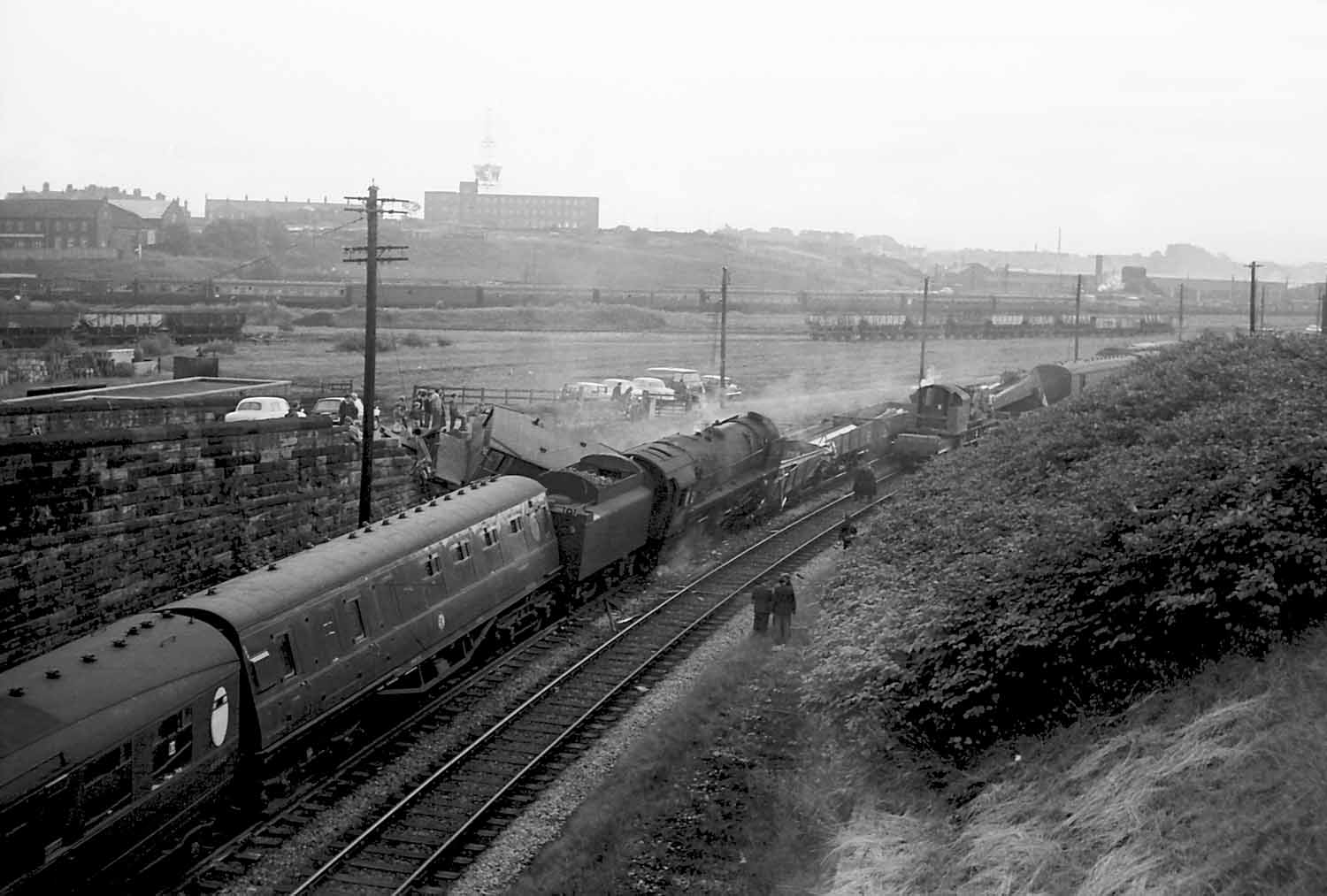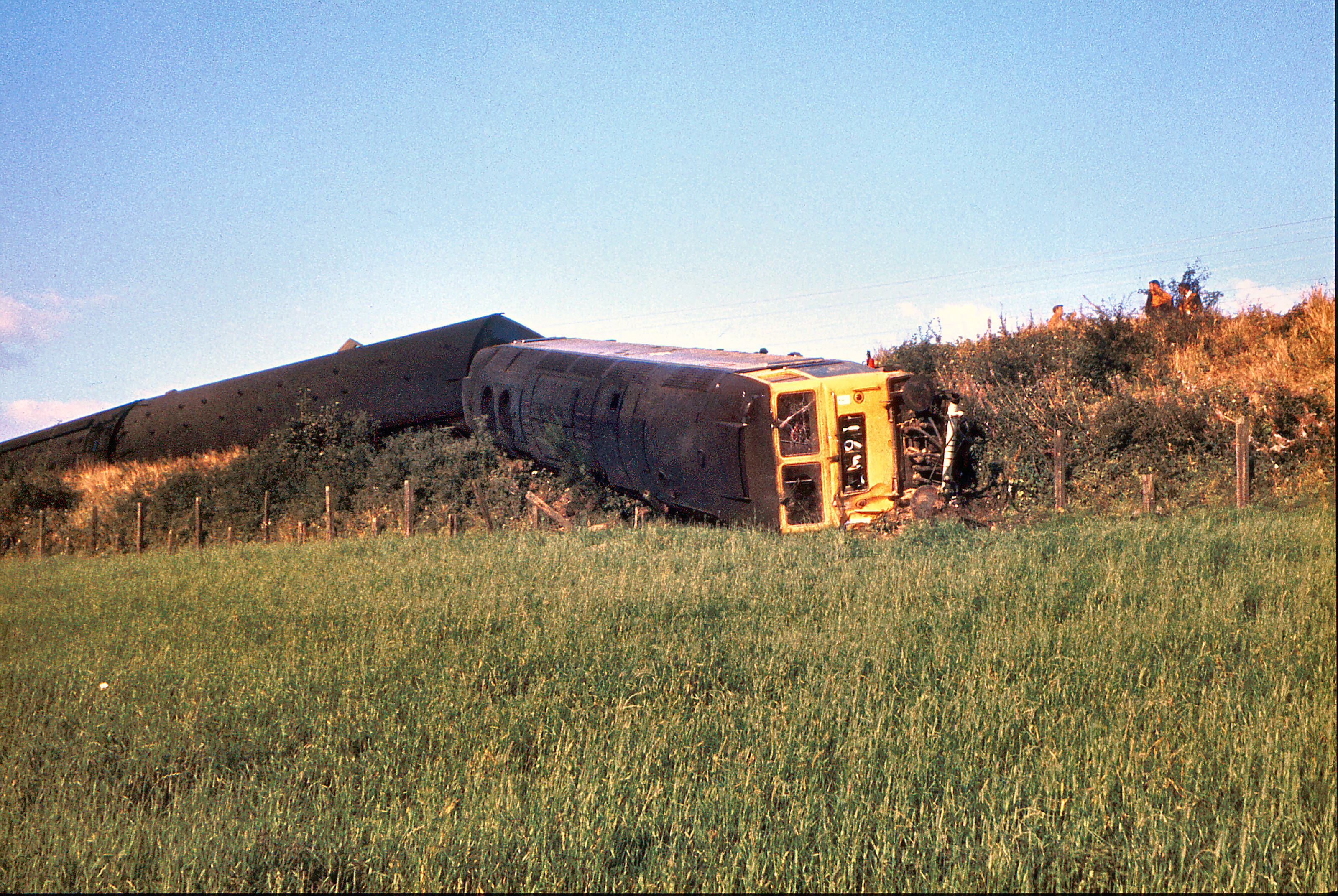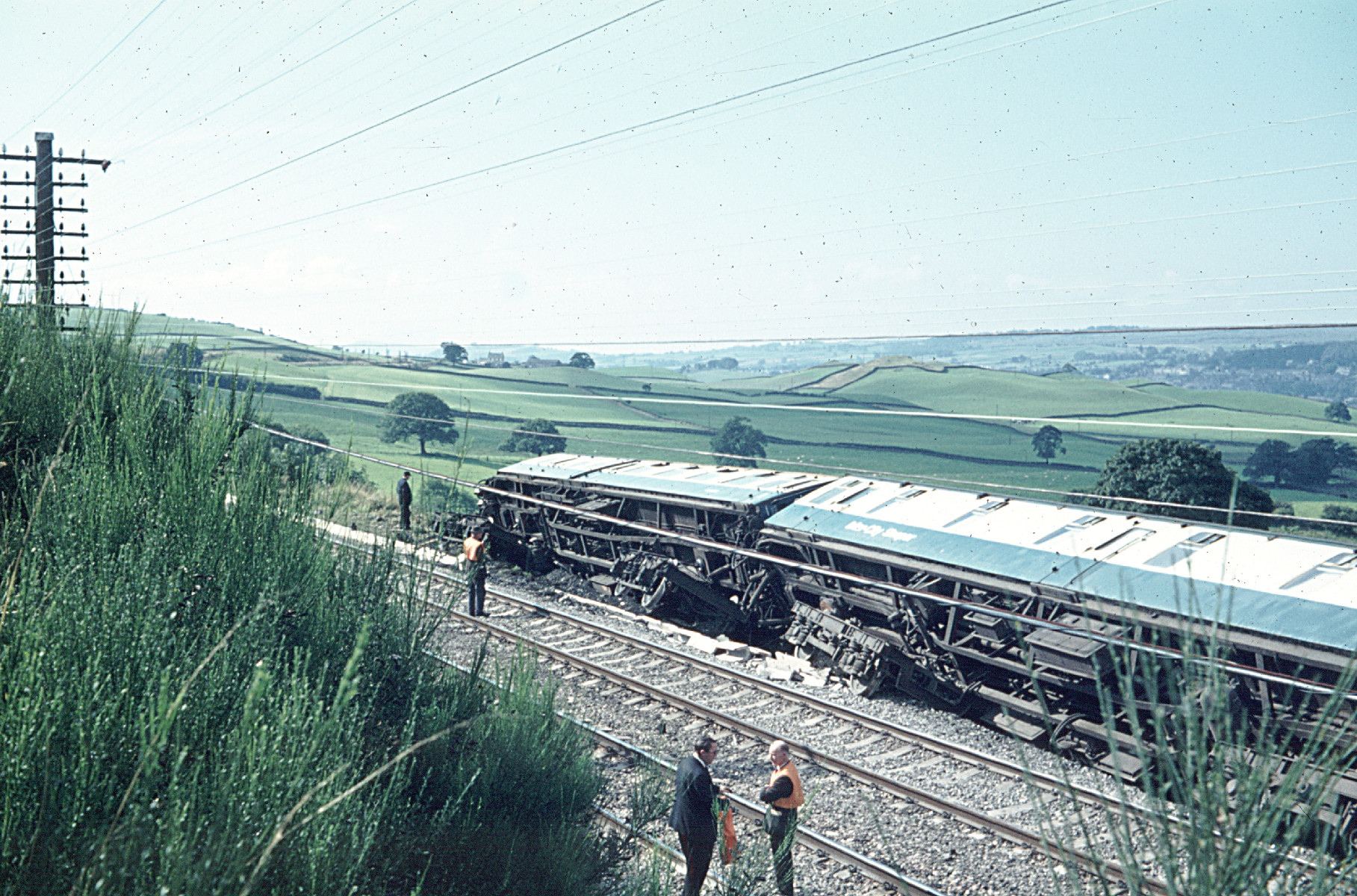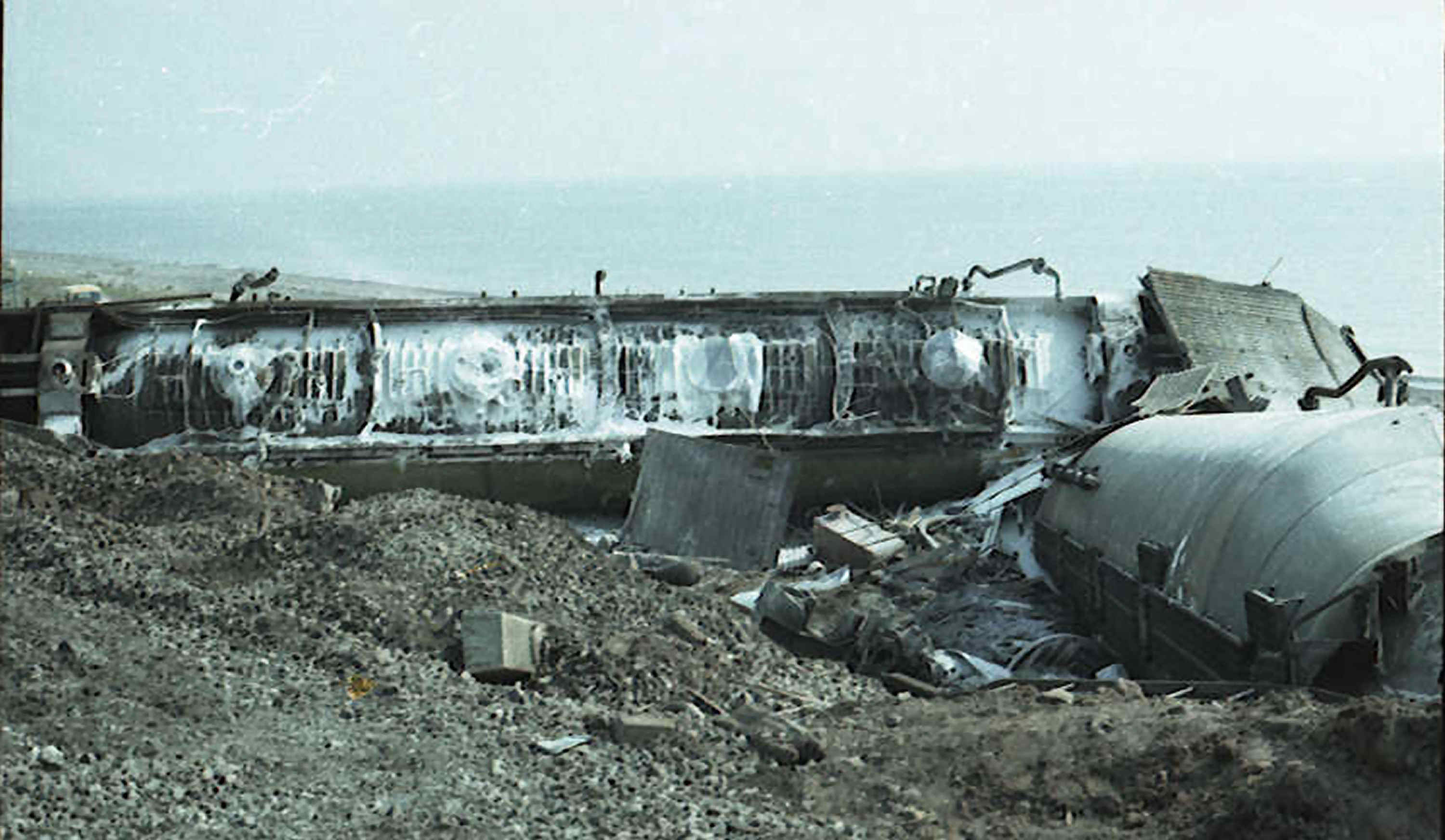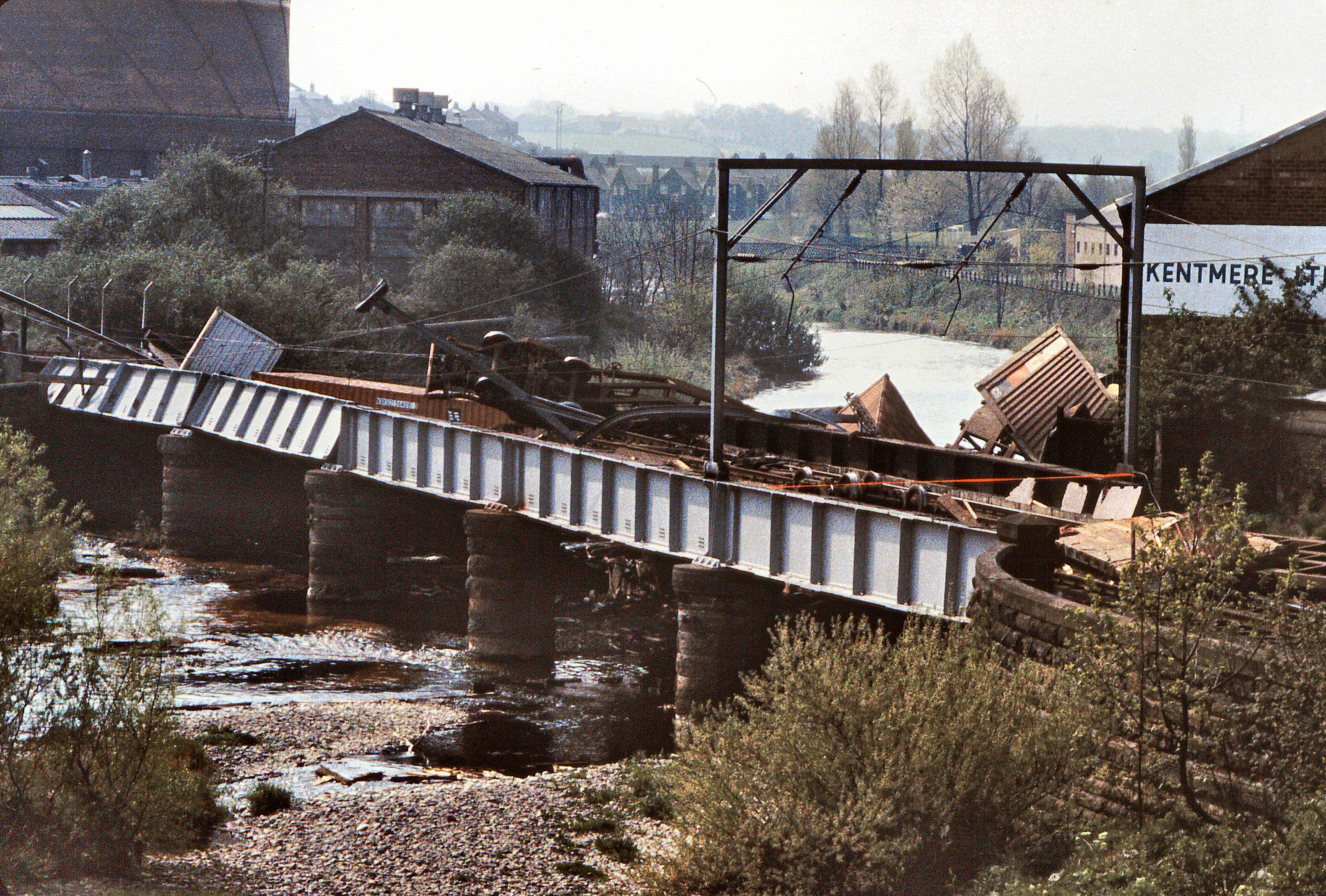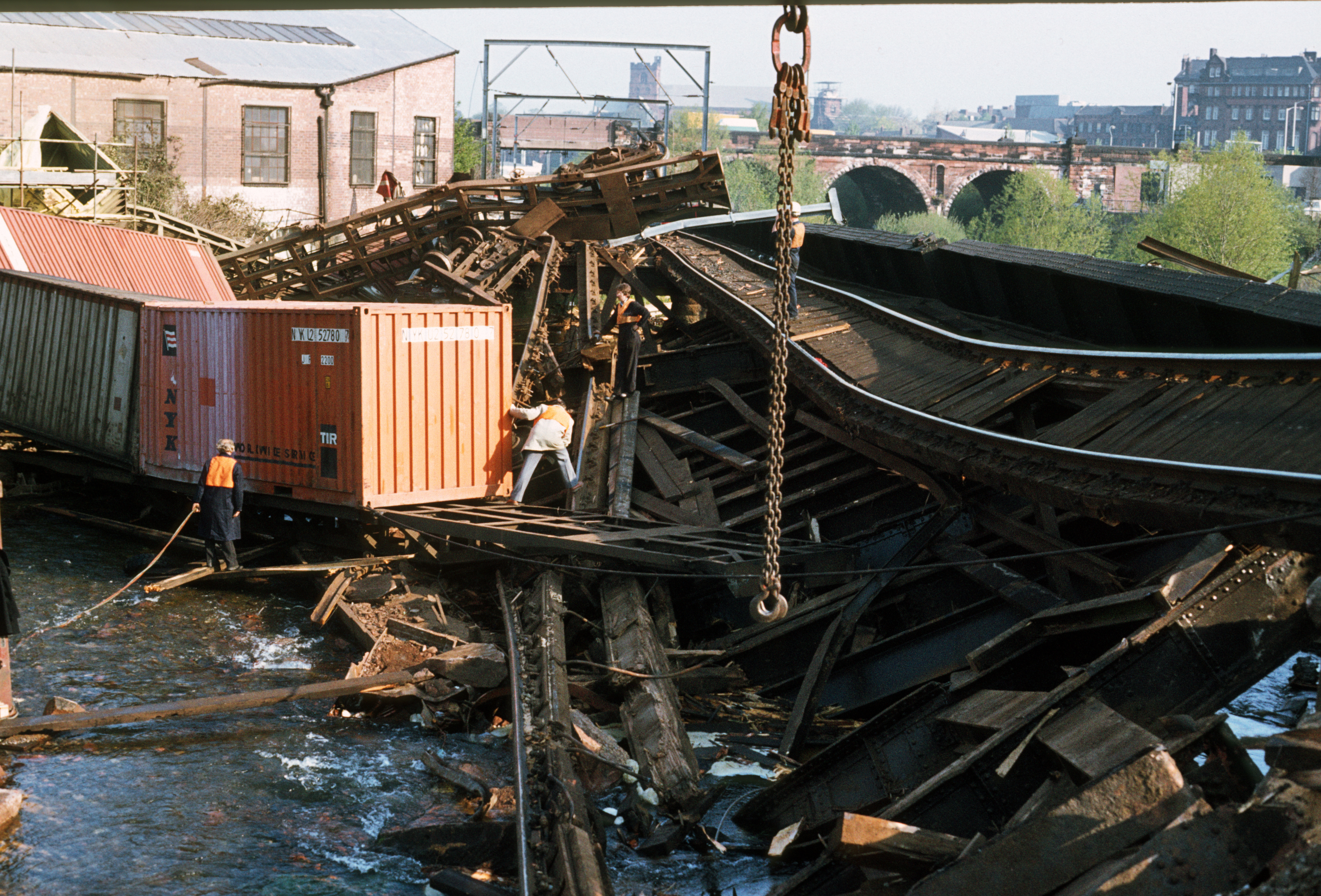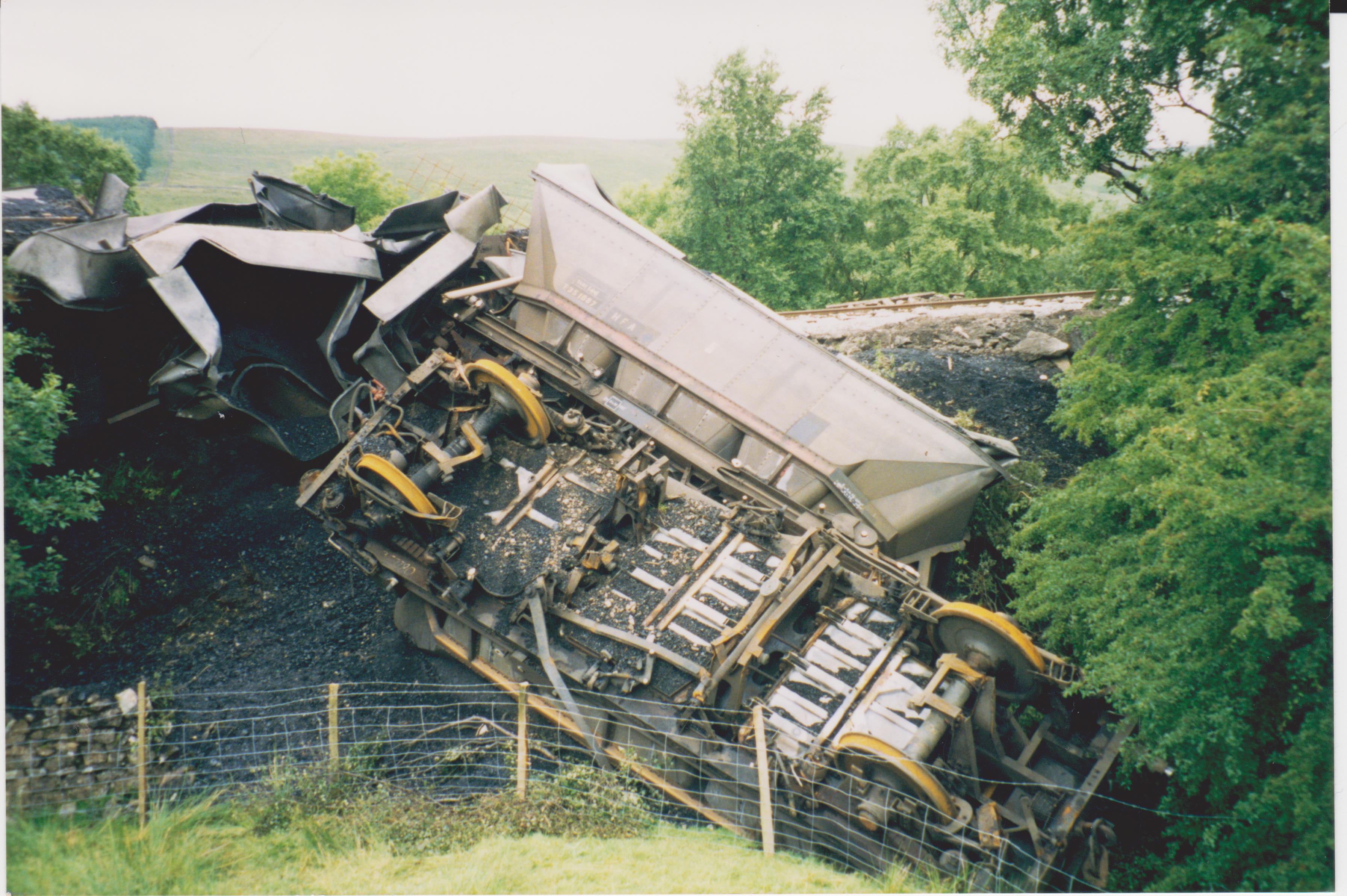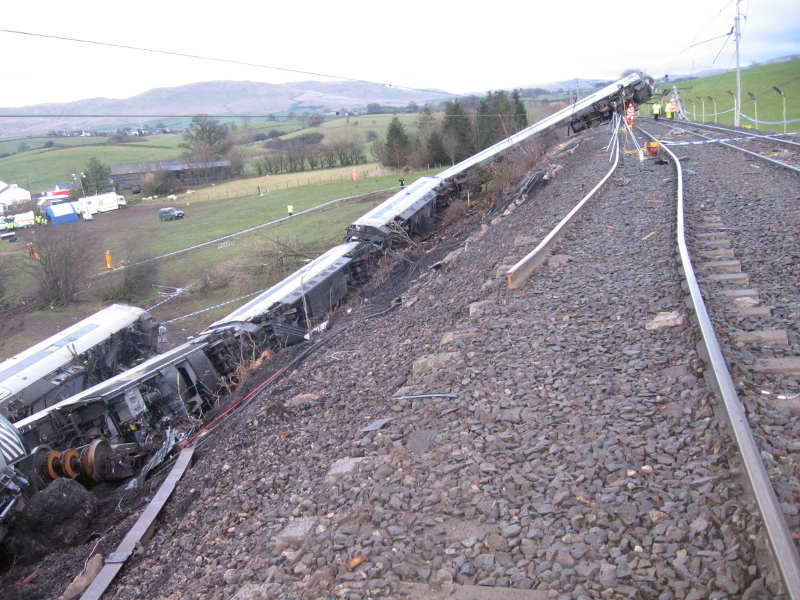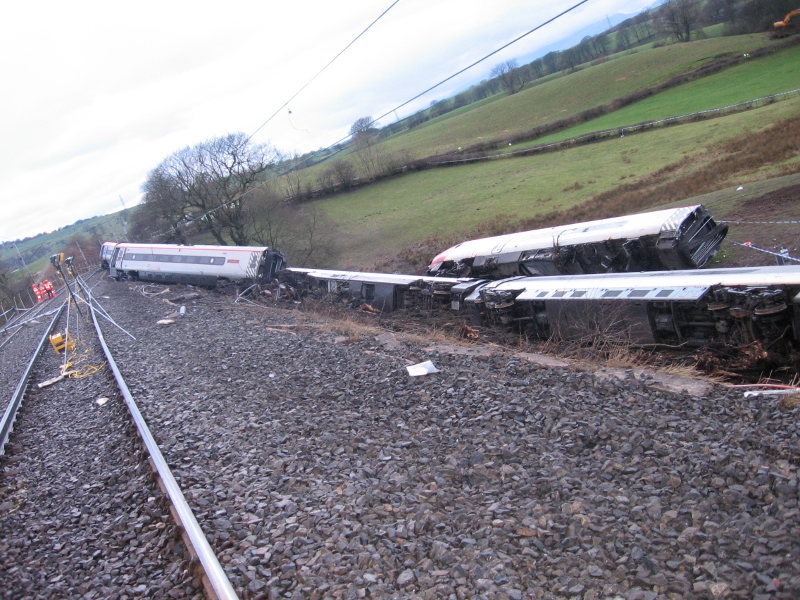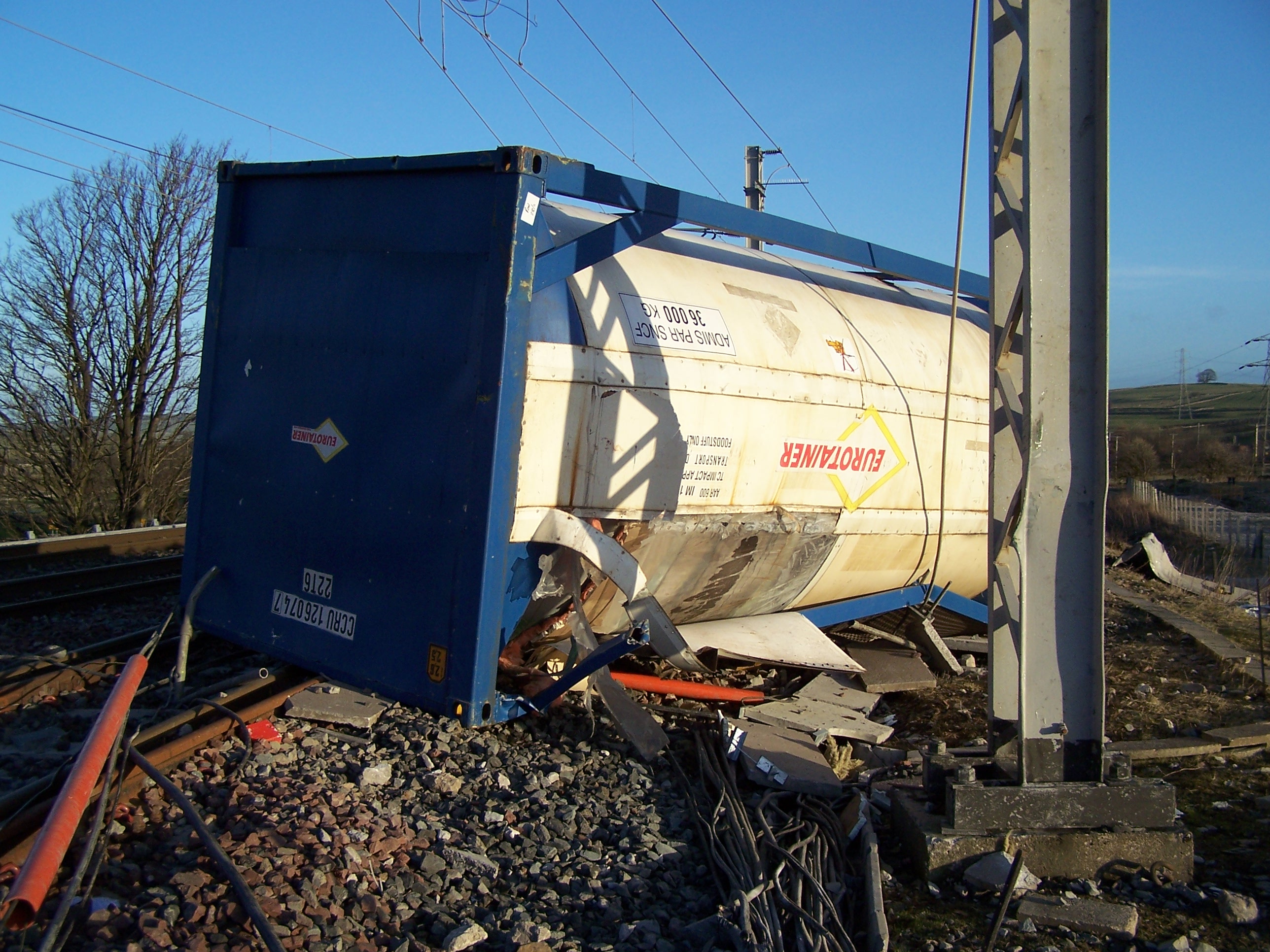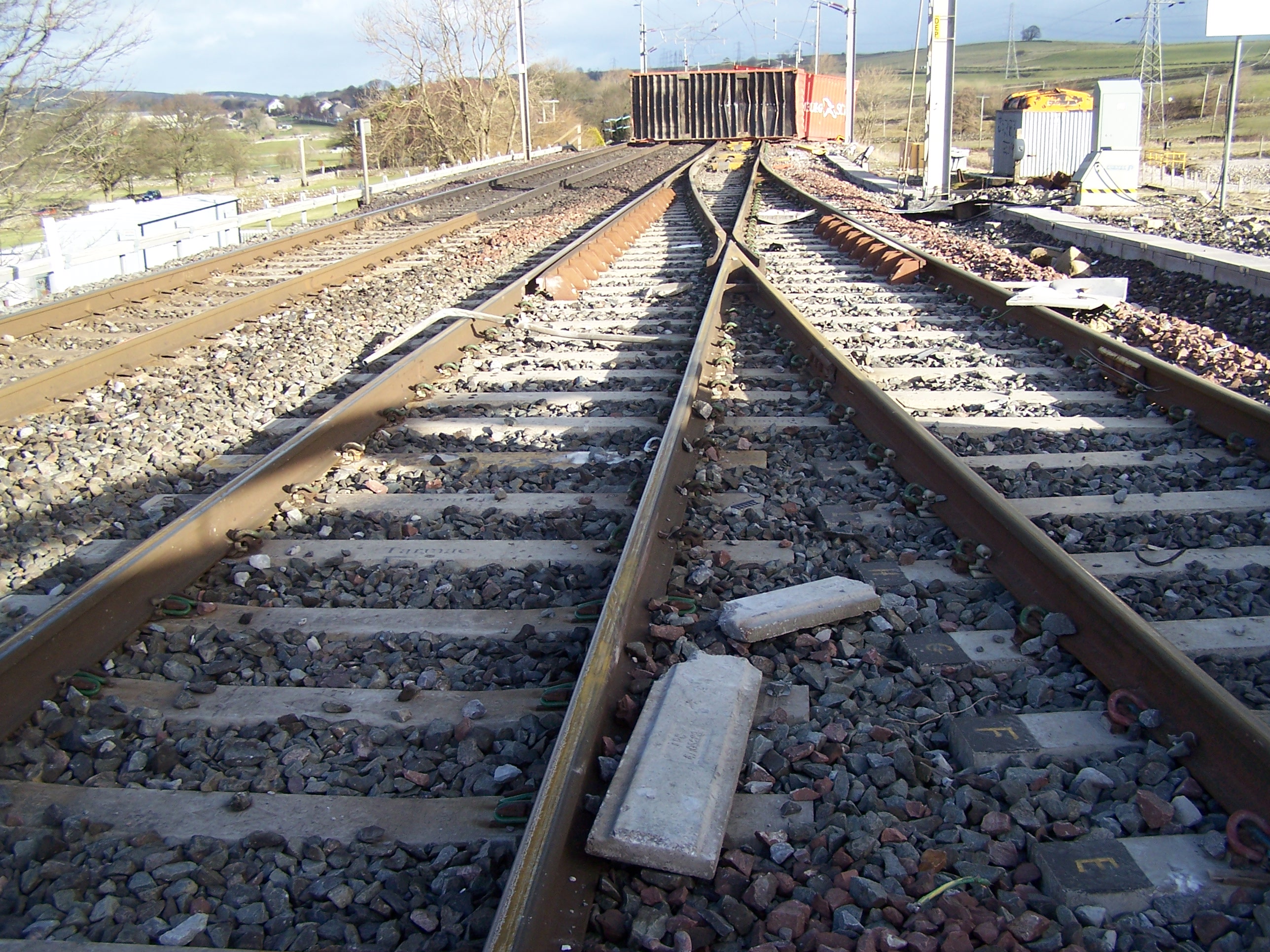RAILWAY ACCIDENTS IN CUMBRIA
The modern railway is an extremely safe mode of travel but this has not always been so. In the early days of railways they were also relatively safe, mainly because of the low level and slow speed of rail traffic. However, as they became busier the lack of adequate braking and signalling, and the lack of discipline amongst many staff led to increasing casualty rates - and especially for railway workers.
From the early 1840s a Rail Inspectorate has existed to investigate the causes of rail accidents and to make recommendations for improvements to the design of equipment and operational methods to reduce future risk - and this process continues today. The advent of increasingly sophisticated signalling and other systems have come about through this process - with the railway operators at times having to be forced by legislation to adopt and implement new safety systems. Accidents resulting in passenger fatalities are now exceeding rare, but some risks remain for track workers and especially to those members of the public who trespass on the railway or disregard the basic rules for using level crossings of various types. The safety of the railway is emphasized by the fact that prior to the unfortunate accident at Lambrigg early in 2007, there had not been a single passenger fatality on the West Coast route between Mossband, north of Carlisle, and Winwick Junction, near Warrington, for well over 100 years.
The reports of the railway inspectors into all types of accidents on the railway provide detailed insights into the realities of railway operation at the time - and of the people involved. The older reports give an eye into a world which is very different from our own, not just in the methods of railway operation, but also into the social environment and attitudes of the period. As such they are very significant historic documents.
The list below does not pretend to be a complete listing of all accidents on the railway in Cumbria - though we intend to extend it in due course. It does include, however, the more significant events which have occurred, some of which have had important influences on subsequent railway operation and management. Many of these are discussed in the publications listed in the "Further Reading" section at the foot of the list.
Clicking on the links will take you to the appropriate page of The Railways Archive website from where the full report may be downloaded. Where no link is given no report is available from The Railways Archive but details will almost always be found in local newspaper reports dating from a few days later. On any accident these reports will probably give additional information not included in the railway inspectors reports and will be found in the Cumbria County Council local studies library for the relevant part of the county, or - for researchers from further away - in the British Library Newspaper Archive.
1836, December - Corby (Newcastle & Carlisle Railway)
Points not reset, train derailed, 3 fatalities
1844, 1st. May - Carlisle (Newcastle & Carlisle Railway)
Boiler explosion, loco No.22 Adelaide
1845, 25th. January - How Mill (Newcastle & Carlisle Railway)
Boiler explosion, loco No.25 Venus
1849, January - Maryport (Maryport & Carlisle Railway)
Boiler explosion, loco No.1
1849, 10th. February - Rockcliffe (Caledonian Railway)
Derailment caused by broken axle, 5 fatalities
1861, 29th. August - Bowes (Stockton & Darlington Railway)
Excursion derailed by bridge subsidence
1870, 10th. April - Grayrigg (Lancaster & Carlisle Railway)
Broken wheel, passenger/postal train derailed
1870, July - Carlisle St Nicholas (London & North Western Railway)
Collision at crossing on level, 6 fatalities
1872, 27th. November - Shap Summit (London & North Western Railway)
Derailed wagon run into by passenger train
1874, 3rd. January - Shap (London & North Western Railway)
Collision between passenger and goods trains after SPAD
1876, 28th. January - Loups Fell, Tebay (London & North Western Railway)
Banking loco collides with passenger train, 1 fatality
1881, 10th. November - Carnforth (Furness Railway)
Insecure points caused derailment
1903, 27th. February - Leven Viaduct (Furness Railway)
Passenger train overturned in gale
1903, 5th. December - Penrith (London & North Western Railway)
Divided train, rear end collision
1910, 24th. December - Hawes Junction (Midland Railway)
Passenger train collides with light engines, 9 fatalities
1912, 22nd. July - Hest Bank (London & North Western Railway)
Signaller error, rear end collision
1913, 2nd. September - Ais Gill (Midland Railway)
Passenger trains in rear end collision, fire, 14 fatalities
1915, 22th. May - Quintinshill (Caledonian Railway)
Passenger trains in double collision, fire, 227 fatalities
1918, 19th. January - Long Meg (Midland Railway)
Cutting slip, express derailed, 7 fatalities
1918, 20th. November - Millom (Furness Railway)
Broken coupling, rear end collision
1926, 30th. August – Naworth (LNER – N&C)
A charabanc type motor coach was erroneously waved across the level crossing by the crossing keeper and was hit by a Newcastle - Carlisle passenger train. 8 occupants of the vehicle died and 6 were injured and the crossing keeper was also killed. There was only very slight damage to the locomotive and no injuries to people on the train.
1928, 25th. October – Dinwoodie to Wamphray (LMSR – Caledonian)
At 3 am a double headed night sleeper from Euston to Aberdeen/Inverness ran into the rear of a failed freight train at approximately 60 mph. All the 4 Carlisle Kingmoor drivers and firemen off the sleeper were killed instantly and there were 5 injuries. The cause was due to irregular working by signalmen.
1930, 6th. March – Culgaith (LMSR – S&C)
A ballast train, with engine facing south, was working on the Down line in Waste Bank tunnel (north of Culgaith) when a local passenger train from Hellifield to Carlisle ran head first into it at an estimated speed of 35 mph. Both locomotives tipped over and there was other extensive damage with the line closed for 48 hours. There were 2 fatalities and 8 injuries and the cause was due to a signal passed at danger from the station stop at Culgaith.
1931, 3rd. January – Port Carlisle Jn., Carlisle (LMSR – Caledonian)
The 12.00 Edinburgh Waverley – St. Pancras LNER passenger train derailed on a tight curve between Willowholme Jn. and Port Carlisle Jn. The loco tipped over into an ash tip and the first 4 coaches were wrecked and the 5th derailed. 3 passengers were killed and there were 27 staff and passengers injured. The cause was due to an Edinburgh driver exceeding the speed limit of 15mph on the curve.
LNER D49 4-4-0 No. 2758 lies on its side partially buried after the derailment.
1933, 10th. July – Little Salkeld (LMSR – S&C)
The 12.44 pm Carlisle – St. Pancras express had a sidelong collision, at nearly 60mph, with a local freight train shunting over the crossover. There was extensive damage and the driver of the shunting loco was killed and there were 35 injuries. The cause was signalling irregularities by the porter-signalman at Little Salkeld.
1933, 19th. December – Hellifield (LMSR – Midland/L&Y)
At 4.25 am, and in thick fog, a brake van ran away out of the sidings and down the incline towards Blackburn in the wrong direction. About a mile and a half away a freight train collided with it head on and the locomotive tipped over and fell down a steep embankment killing the driver and fireman. There were failings by 3 members of staff which lead to the incident – the guard, the shunter and signalman at Hellifield Goods Yard. The LMSR was also requested to investigate a safer method of working for the location.
1939, 25th. August – Kirkby in Furness (LMSR – Furness)
At 01.45 a special passenger train from the Southport Flower Show was just departing the station when it was hit in the rear by another special from Southport which was booked to run non-stop through the station. The rear coach of the first train was badly damaged as was the front of Stanier Mogul 2949 on the second train with approximately 30 injuries and at least 13 requiring hospital attention. The guard had to have an arm amputated. Due to the outbreak of war there does not appear to have been a formal investigation.
1940, 5th. November - Gretna Junction (LMSR - Caledonian)
A Euston – Perth express passenger train collided with an Up freight train crossing from the G&SW line. The express driver and 2 passengers were killed and 40 others hospitalised but no conclusion was reached on the cause.
1941, 6th. March – Garsdale. (LMSR – S&C)
A rear end collision and derailment with 1 fatality is all the information available.
1944, 15th. May - Mossband (LMSR - Caledonian)
A Euston – Glasgow night sleeper derailed at speed with the locomotive (6225 ‘Coronation’ class) and 10 out of 12 coaches affected. 3 passengers were killed and 9 taken to hospital. After extensive renewal work during the day and the passage of a few trains the track became unsafe causing the derailment.
1945, 22nd. March - Bootle (LMSR - Furness)
A Workington – Liverpool freight train conveyed naval depth charges in the first 7 open vehicles. The driver, fireman and signalman all noticed a fire in the 6th. vehicle. The driver stopped just south of Bootle to allow the fireman to detach the vehicles behind the one on fire, draw forward and detach it, then draw forward with the remaining 5 to isolate the fire. It is assumed the driver, H. Goodall, went back to investigate but was caught up in a massive explosion and was killed. The cause was down to a spark from the locomotive settling in the open wagon.
The scene at Bootle in daylight after the explosion of the ammunition wagon. Looking South, the huge crater is visible with the leading 6 wagons left on the Up line, and an engine on the Down line.
CRA Miscellaneous Collection M10412.
1947, 18th May (Sunday) - Lambrigg (LMSR - L&C)
Single Line Working (SLW) was in operation over the Down line between Lambrigg and Oxenholme No. 2 with the Up line blocked for track work. The Carlisle driver of a Glasgow – Euston express failed to notice the Up distant signal at caution, passed the home signal at danger whilst braking and collided with a light locomotive at approximately 25 – 30 mph. on Docker Viaduct. The loco. was positioned correctly to assist heavy trains to reverse through the crossover, on the 1 in 106 gradient, to gain the Down line for SLW. There were 33 non-serious injuries.
1952, 18th. April – Blea Moor (BR – S&C)
The Up ‘Thames-Clyde Express’ became derailed, at speed, on the facing points into the Up loop. Due to poor maintenance some of the brake rigging on the leading locomotive (46117) came adrift and ‘bounced’ for a considerable distance before it struck the stretcher bar of the points and moved them under the following loco. which derailed. 34 injuries.
1952, 16th, August – Carlisle Etterby Jn. (BR – Caledonian)
The 11.40 p.m. Newcastle – Stranraer was awaiting the signal at Etterby Jn. when a ‘light’ engine travelling tender first from Citadel to Kingmoor MPD passed the Caldew Jn. starting signal at danger and collided with the stationery train at 15 – 20 mph. The train was buckeye coupled and there was no derailment but 22 passengers were injured due to the severe shock of the collision.
1955, 20th. May – Smardale (BR – NER, SD&LUR)
A Tebay – Kirkby Stephen empty mineral working became derailed with both locomotives falling down an embankment. The locos were LNER type Q6 63355 & 63373 and were running tender first. The cause was put down to a broken tender spring, speed and condition of track.
1955, 22nd. December – Hellifield (BR – Midland)
The 9.05 pm St. Pancras – Edinburgh night express was performing station duties in the Down platform when it was struck in the rear by the 9.15 pm St. Pancras – Glasgow night express which was not booked to call at Hellifield. The second train had reduced speed to 25 – 30 mph but 2 passengers and 3 staff were injured and the 2 rear passenger brake vans were destroyed. Irregular working by the signalman was the cause.
1960, 21st. January – Near Settle (BR – S&C)
An Up express was being hauled by a BR Britannia locomotive on which the right hand motion became displaced and eventually dug 6ft. down into the 6ft. way and damaged the Down line where a freight train became derailed and collided with the passenger train. There were 5 fatalities and 9 injured and the cause was ‘inadequate maintenance’ of the locomotive.
1960, 2nd. March – Penrith, Eamont Jn. (BR – L&C)
A Camden – Carlisle fitted freight on entering the Down Loop became derailed with the locomotive LMSR Black 5 45197 becoming buried up to 12ft. in the ground. Most of the 34 wagons were smashed up and the rest derailed and 4 staff were injured. The likely cause was speed on entering the loop.
1967, 6th. December – Calthwaite (BR – L&C)
7S73 Hardendale – Ravenscraig lime train derailed blocking both lines of the WCML until the evening of the 8th. Dec.
1968, 30th. October – Selside (BR – S&C)
5P28 20.19 Warrington – Carlisle freight train was awaiting clearance of the Down home signal at Selside when it was run into by the following freight train 5P31 22.15 Preston – Carlisle. 5P31 had passed both home and starting signals at danger at Horton-in-Ribblesdale. The loco. and 24 out of 36 wagons of 5P31 and 14 wagons of 5P28 were derailed and badly damaged along with the track. Only the driver and guard of 5P28 received minor injuries and the cause was down to the driver of 5P31 being intoxicated.
1968, 21st. November – South of Ravenglass (BR – Furness)
4L25 Heysham – Corkickle oil train derailed at speed with 16 out of 18 loaded tanks coming off the line. There was much damage and thick oil spread all over the site and the line was closed for nearly a week. The cause was a wagon defect.
1971, 10th. September – Hayfell near Oxenholme (BR – L&C)
Single Line Working (SLW) was in operation between Oxenholme & Lambrigg, over the Down line, for WCML electrification work. 1M91 Stirling – Sutton Coldfield Motorail, an Up service, was running along the Down line and became derailed on catch points with the loco. and leading coaches careering down a steep embankment resulting in 4 injuries. The cause was inadequate communication between Movements Supervisors with one unlocking the catch points prematurely and against Rule Book instructions.
1988, 5th. February – Carnforth Up Furness Line
A DMU on the main line hit a freight which was being shunted into Bottom End Yard siding adjacent. The Shunters didn't know there were already wagons there and the resulting collision derailed the wagons into the path of the DMU.
1990, 26th. February – Kirkby-in-Furness (BR – Furness)
A Barrow – Carlisle Class 108 DMU passenger service became derailed due to the high tide and flooding and a wooden sleeper becoming foul of the Down line.
1993, 18th. December – Carlisle London Rd. Jn. (BR - NER )
6E46 Hardendale – Lackenby derailed on the junction with 12 PGAs, loaded with lime.
1995, 31st. January – Ais Gill (Mallerstang) (Railtrack NE – S&C) TOC – RRNE
A Class 156 Sprinter DMU ran into a landslip in a cutting on the Down line and derailed towards the Up line where it was hit by another Class 156 with 1 staff fatality and passenger injuries.
1995, 7th. August – Workington Siddick Jn. (Railtrack NW – LNWR) TOC – RRNW
The 14.25 Carlisle – Barrow, a Class 142 Pacer DMU, derailed after the gear box fell from under the unit into the 4ft. of the Up line.
1997, 27th. February – Carnforth South Jn. (Railtrack NW – L&C)
3 out of 4 Class 31s derailed at speed on the Up WCML causing massive track and signalling damage but no injuries. The WCML was blocked for over 3 days with many S&C diversions. The cause was binding brakes causing wheel flats.
1998, 15th. July – Denthead (Railtrack NW - S&C)
7Z32 Carlisle Yard – High Marnham loaded coal train derailed with 33 out of 36 HHA (Merrygoround) type wagons ploughing up both lines and damaging an underbridge but with no injuries. The cause was put down to lack of maintenance and renewals of the track and instigated the eventual full renewal of all track on the S&C.
The devastation caused by the derailment of 7Z32.
Image from the CRA Tony Freschini Collection.
Note the poor state of the wooden sleepers.
Image from the CRA Tony Freschini Collection.
1999, 15th. January – Crosby Garrett (Railtrack NW – S&C) TOC – Northern Spirit
A Leeds – Carlisle passenger service worked by a Class 156 Sprinter derailed towards the Up line on a landslip on approach to the tunnel and was in collision with an Up loaded coal train. There were no injuries.
1999, 22nd. October – Shap (Railtrack NW – L&C)
Not a rail accident but an RAF Hawk jet crashed into the A6 bridge at the north end of Shap village killing both pilots and seriously damaging OHLE, signalling equipment etc. on the WCML with numerous cancellations and delays.
2002, 17th. June – Quintinshill (Network Rail – Caledonian) FOC – EW&S
4M63 Mossend – Warrington freight train derailed at speed on the approach to Quintinshill (under Carlisle PSB control) causing extensive track damage on both lines. All 14 loaded OTA timber wagons on the train were destroyed but the electric locomotive, 92039, was undamaged and the WCML was closed for a week. The cause was a hot axle box and defective hot axle box detectors.
2003, 19th. April – Shap (Network Rail – L&C) FOC – EW&S
An engineering train collided with the rear of another one within an engineers possession and became derailed. There was one injury.
2004, 15th. February – Tebay (Network Rail - L&C)
Whilst being unloaded within an engineers possession a Road Rail Vehicle (RRV) trailer, loaded with scrap rail, ran away from Scout Green down the 1:75 incline for over 3 miles and collided with a group of men maintaining the track at Tebay South. There were 4 fatalities and 5 injuries. The main cause was the illegal tampering with the brakes of the trailer by the sub-contractors.
2006, 6th. February – Carlisle North Jn. (Network Rail – Citadel JC)
A ballast train returning from a worksite at Barrow became derailed. Only the plough brake was derailed due to the plough not being secured correctly and gradually lowering on to the track.
2007, 23rd. February – Lambrigg (Network Rail – L&C) TOC – Virgin WC
1S83 17.15 Euston – Glasgow Pendolino derailed on the ground frame controlled facing crossover, at speed, and careered off the line wrecking the train and much of the infrastructure. There was 1 fatality and 28 serious injuries including the driver. The WCML was closed for 2 weeks with many S&C diversions; the cause was poor maintenance of the points.
The scene of carnage at Lambrigg on the morning after the derailment, with Pendolino 390033 ‘City of Glasgow’ lying wrecked down the bank.
Looking north showing damage to track, embankment, overhead line equipment etc.
Image from the Ken Harper Collection.
Looking south towards the defective points; the leading power car has turned 180 degrees to face south.
Image from the Ken Harper Collection.
2008,28th. February – Wraysholme (Network Rail – Furness) TOC – Transpennine Express.
The 08.27 Manchester Airport – Barrow collided with a car on the automatic level crossing and both driver and passenger were injured. The cause was down to ‘road vehicle driver error’.
2008, 1st. March – Hardendale, Shap (Network Rail – L&C) FOC- Freightliner
4S83 Tilbury – Coatbridge had 5 containers blown off the train causing extensive damage. The cause was high winds and poor container retention design.
One of five containers fouls the Up Main line after being blown off 4S83 at Shap, Hardendale.
Image from the Ken Harper Collection.
A container fouls both main lines at the entrance to the sidings with debris in the foreground.
Image from the Ken Harper Collection.
2008, 3rd. November - Wraysholme (Network Rail – Furness) TOC – Northern
The 09.37 Carlisle – Lancaster collided with a car on the automatic level crossing and there was 1 fatality. The cause was down to ‘road vehicle driver error’.
2009, 1st. June – Cummersdale (Network Rail – M&C) TOC – Northern
2C31 13.05 Whitehaven – Carlisle, a single car Class 153, derailed on distorted track. The weather was extremely hot which caused the track to buckle but there were other safety issues involved.
2009, 4th. July – Penrith (Network Rail – L&C) FOC – DRS
Probably as a result of criminal activity, 2 container doors came open on 4M16 Mossend – Daventry and were struck by a TPE Class 185. After recessing in Eden Valley loop, a Virgin Pendolino and Voyager were also damaged, all with no injuries.
2010, 17th. August – Tebay (Network Rail – L&C) FOC – DB Schenker
At 02.04 a Down (northbound) freight train slowed to a halt and then started to run back down Shap incline. It ran back for 2.2 miles and reached 51mph before the driver braked it to a halt but Carlisle PSB had already made emergency preparations. Luckily there were no other trains in the area. The cause was down to driver error.
2012, 30th. August – St. Bees (Network Rail – Furness) TOC – Northern
2 Class 153 DMUs forming an early morning Maryport – Lancaster service derailed on the single line between St. Bees and Nethertown. Extreme rain over the previous few days caused a land slip from the steep slope above the line. No injuries.
2014, 12th. January – Kitchen Hill north of Penrith (Network Rail – L&C)
On a weekend Engineers Possession of the WCML a works train collided with the rear of another and became derailed. One driver was injured.
2015, 7th. March – Scout Green (Network Rail – L&C) FOC – Freightliner
4S83 Crewe – Coatbridge had one container blown off the train on the Down line; the container crossed the Up line coming to rest on the Up embankment. There was little damage, and it was a similar incident to that on 1st. March 2008, with the same causes.
2022, 19th. October – Petteril Bridge Jn., Carlisle (Network Rail – Mid/NER) FOC – GBRF.
Five tank wagons loaded with cement powder on 6C00 17.15 Clitheroe – Carlisle Yard derailed on the Down line at Petteril Bridge Junction. Two of the tanks fell into the river, and both lines from Carlisle to Leeds and Newcastle were blocked for seven weeks due to the difficult recovery operation and significant damage to the track and bridge over the River Petteril.
Image from the Ken Harper Collection.
There were no injuries. The cause was due to poor railhead conditions resulting in a wheelset not rotating for over fifty miles, with the resultant flat wheel derailing on points. Leasing company VTG Rail are trialling "axle lock detection and Wheel Flat Prevention (WFP) technology – a patented system which monitors wheelset slide and brake condition". See our LINKS page.
Image from the Ken Harper Collection.
(Page last updated November 2023.)
Further reading on accidents generally:
Red for Danger, L T C Rolt (Various editions and publishers, 1955 to 1998)
Historic Railway Disasters, O S Nock (Ian Allan, various editions from 1966)
Railway Accidents, Stanley Hall (Ian Allan, 1997)
Railway Detectives, The 150-year Saga of the Railway Inspectorate, Stanley Hall (Ian Allan, 1990)
Danger Signals, An investigation into modern railway accidents, Stanley Hall (Ian Allan, 1987

